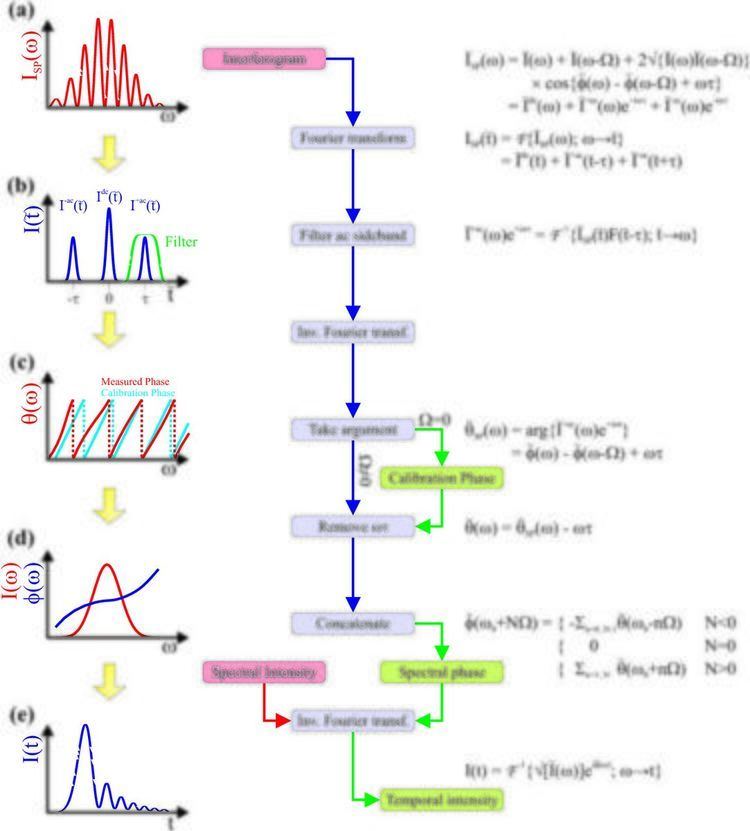 | ||
In ultrafast optics, spectral phase interferometry for direct electric-field reconstruction (SPIDER) is an ultrashort pulse measurement technique originally developed by Chris Iaconis and Ian Walmsley.
Contents
The basics
SPIDER is an interferometric ultrashort pulse measurement technique in the frequency domain based on spectral shearing interferometry. Spectral shearing interferometry is similar in concept to lateral shearing interferometry, except the shearing is performed in the frequency domain. The spectral shear is typically generated by sum-frequency mixing the test pulse with two different quasi-monochromatic frequencies (usually derived by chirping a copy of the pulse itself), although it can also be achieved by spectral filtering or even with linear electro-optic modulators for picosecond pulses. The interference between the two upconverted pulses allows the spectral phase at one frequency to be referenced to the spectral phase at a different frequency, separated by the spectral shear - the difference in frequency of the two monochromatic beams. In order to extract the phase information, a carrier fringe pattern is introduced, typically by delaying the two spectrally sheared copies with respect to one another.
Theory
The intensity of the interference pattern from two time-delayed spectrally sheared pulses can be written as
where
The unknown spectral phase of the pulse can be extracted using a simple, direct algebraic algorithm first described by Takeda. The first step involves Fourier transforming the interferogram into the pseudo time domain:
where
One of the ac sidebands is filtered out and inverse Fourier transformed back into the frequency domain, where the interferometric spectral phase can be extracted:
The final exponential term, resulting from the delay between the two interfering fields, can be obtained and removed from a calibration trace, which is achieved by interfering two unsheared pulses with the same time delay (this is typically performed by measuring the interference pattern of the two fundamental pulses which have the same time-delay as the upconverted pulses). This enables the SPIDER phase to be extracted simply by taking the argument of the calibrated interferometric term:
There are several methods to reconstruct the spectral phase from the SPIDER phase, the simplest, most intuitive and commonly used method is to note that the above equation looks similar to a finite difference of the spectral phase (for small shears) and thus can be integrated using the trapezium rule:
This method is exact for reconstructing group delay dispersion (GDD) and third order dispersion (TOD); the accuracy for higher order dispersion depends on the shear: smaller shear results in higher accuracy.
An alternative method us via concatenation of the SPIDER phase:
for integer
The spectral intensity can be found via a quadratic equation using the intensity of the dc and ac terms (filtered independently via a similar method above) or more commonly from an independent measurement (typically the intensity of the dc term from the calibration trace), since this provides the best signal to noise and no distortion from the upconversion process (e.g. spectral filtering from the phase matching function of a 'thick' crystal).
Alternative techniques
Spatially encoded arrangement for SPIDER (SEA-SPIDER) is a variant of SPIDER. The spectral phase of an ultrashort laser pulse is encoded into a spatial fringe pattern rather than a spectral fringe pattern.
Other techniques are frequency-resolved optical gating, streak camera with picosecond response times, and multiphoton intrapulse interference phase scan (MIIPS), a method to characterize and manipulate the ultrashort pulse.
